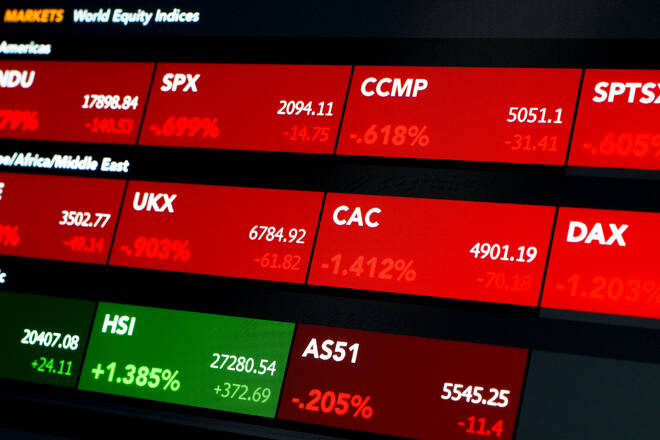Advertisement
Advertisement
European Equities: A Week in Review – 14/01/22
By:
Market sentiment towards FED monetary policy leaves the majors in the red following another spike in U.S inflation.
The Majors
It was a bearish week for the European majors in the week ending 14th January.
The DAX30 slipped by 0.40%, with both the CAC40 and EuroStoxx600 the ending the week down by 1.05% respectively.
It was a choppy week for the global equity markets, with market sentiment towards FED monetary policy the key driver in the week.
Early in the week, FED Chair Powell testimony had pointed to just 3 rate hikes for the year to curb inflationary pressure. December inflation figures from the U.S on Wednesday, however, left FOMC hawks to take a more hawkish stance later in the week.
A number of FOMC members talked of the need for 4 rate hikes, leading to a tech sell-off late in the U.S session on Thursday. The negative sentiment filtered through to the European majors on Friday, leaving the majors in the red for the week.
Economic data from the Eurozone largely took a back seat in the week.
The Stats
Key stats included Eurozone unemployment, industrial production, and trade data for November.
The stats were skewed to the positive. The Eurozone’s unemployment rate fell from 7.3% to 7.2%, with industrial production up 2.3% in the month. Production had fallen by 1.3% in October.
Trade data was market negative, however, while finalized inflation figures for France and Spain had a muted impact on the majors. The Eurozone’s trade balance narrowed from a €3.3bn surplus to a €1.5bn deficit in November. It was the Eurozone’s first goods trade deficit since January 2014.
From the ECB, the Economic Bulletin sent mixed signals, while suggesting that inflation was more than just transitory.
From the U.S
It was a big week for the Dollar. In the first half of the week, FED Chair Powell testimony and December inflation figures were key drivers.
While the FED Chair talked of the need to hike rates, there was no mention of the need for more than 3 this year. This was taken as a positive for the riskier assets and negative for the Dollar.
On Wednesday, another spike in inflation failed to spook the markets. This was in spite of the U.S annual rate of inflation at its highest since 1982. An easing in energy prices for the first time since the uptrend was taken as a sign of a possible topping out.
Jobless claims failed to impress on Thursday, with initial jobless claims increasing from 207k to 230k in the week ending 7th January.
Retail sales figures for December wrapped things up on Friday. In December, retail sales fell by 1.9% versus a forecasted 0.1% decline. Core retail sales tumbled by 2.3% versus a forecasted 0.2% rise.
The Market Movers
From the DAX, it was a mixed week for the auto sector. BMW and Volkswagen rallied by 3.89% and by 2.86% respectively to lead the way, with Daimler rising by 1.67%. Continental bucked the trend, however, with a 0.04% loss.
It was a bearish week for the banking sector. Deutsche Bank and Commerzbank slid by 3.33% and by 5.47% respectively.
From the CAC, it was a bullish week for the banks. Soc Gen rallied by 3.13%, with BNP Paribas and Credit Agricole ending the week with gains of 2.79% and 2.38% respectively.
The French auto sector also had a bullish week. Stellantis NV and Renault rallied by 5.43% and by 4.03% respectively.
Air France-KLM ended the week down by 1.65%, with Airbus falling by 0.31%.
On the VIX Index
It was a 2nd consecutive week the green for the VIX in the week ending 14th January, marking a 6th rise in 9-weeks.
Following an 8.94% gain from the previous week, the VIX rose by 2.29% to end the week at 19.18.
2-days in the green from 5 sessions, which included a FOMC member driven 15.28% jump on Thursday, delivered the upside.
For the week, the Dow fell by 0.88%, with the NASDAQ and the S&P500 ending the week down by 0.28% and by 0.30% respectively.
The Week Ahead
It’s quieter week ahead on the Eurozone economic calendar. Early in the week, ZEW Economic Sentiment figures for Germany and the Eurozone will be in focus. We’ve seen plenty of sensitivity to the numbers of late.
The focus will then shift to finalized inflation figures for member states and the Eurozone and Eurozone consumer confidence figures.
On the monetary policy front, the ECB monetary policy meeting minutes will also draw plenty of interest. The markets are expecting to see a shift in stance on interest rates to curb inflation.
From the U.S, Philly FED Manufacturing and weekly jobless claims figures will be the key stats of the week. Expect another jump in jobless claims to test support for riskier assets…
Ahead of the European open on Monday, economic data from China will set the tone, however, 4th Quarter GDP numbers, along with industrial production and retail sales figures for December will be key.
Away from the Economic Calendar
News updates on COVID-19 will need continued monitoring. While the markets have accepted the less severe Omicron strain, any news of a new strain would weigh on the majors. There are also corporate earnings to draw attention in the week.
About the Author
Bob Masonauthor
With over 28 years of experience in the financial industry, Bob has worked with various global rating agencies and multinational banks. Currently he is covering currencies, commodities, alternative asset classes and global equities, focusing mostly on European and Asian markets.
Advertisement
